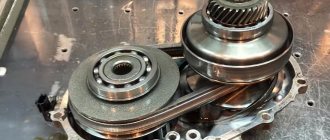As you know, various domestic models produced by AvtoVAZ have long been produced exclusively with a manual transmission. However, not so long ago the popular Lada Granta and Kalina received the long-awaited automatic transmission, which can rightly be considered a great success.
With the launch of the Lada Vesta model on the market, many car enthusiasts, for obvious reasons, also immediately turned their attention to the version with an automatic transmission. Next, we will look at what kind of automatic transmission is installed on the Lada Vesta now, as well as what automatic transmission options may appear on this model in the future.
Prices
In identical configurations, the robot requires an additional payment for the “handle” of 25,000 rubles, regardless of the engine - 1.6 or 1.8. But these are 2022 cars. The CVT on cars produced in 2022, if you count the difference with the base 1.6 engine with manual transmission, raises the price by 95 thousand. Quite a lot! Regarding the 1.8‑liter engine, the surcharge is less - 60 thousand rubles.
Reduced gear shift time: AMT 2.0 compared to the previous version, ms
| Percentage of pressing the accelerator pedal | From first to second | From second to third |
| 30 | 730 | 720 |
| 60 | 690 | 880 |
| 100 | 680 | 550 |
Motor HR16DE (analogous to H4M K-1)
The possibility of equipping the LADA Vesta with the “HR16DE” unit was provided for in advance, but such a complete set of the model did not appear on sale. Today it has been found out that the “XRAY” modification is already equipped with a similar “H4M” engine, although unlike the “K-1” unit, the output of which is 114 “horses,” this engine is derated to the level of 110 “horses”. Rumor has it that the manufacturer intends to refuse to install this motor, since the cost of this modification is very high, which makes the model uncompetitive.
Renault and Nissan models are equipped with the HR16DE engine. These are Fluence, Megan, Duster and Qashqai, Juke respectively. This unit is a constructive continuation of the famous “K4M” engine, which was also equipped with popular Renault small cars.
A distinctive feature of the domestic “clone” will be a modified gas distribution mechanism and a modified electronic control module. This was done for the sake of the environment. There are already approximate data on the expected service life of the HR16DE engine, which exceeds the mark of 250 thousand km.
Among the main advantages of the engine, experts highlight the following aspects:
- automatic control of valve timing (a phase shifter is present on the intake camshaft);
- The resource of the chain drive in the timing belt exceeds the 100 thousandth limit.
Note that not everything is so smooth with this engine - it has lost hydraulic compensators. This fact will force owners during operation to tend to adjust the thermal clearances in the valve mechanism. The procedure should be repeated after 80-100 thousand km, and the cost of the event becomes more expensive due to the need to select pushers. This drawback cannot be considered as a real problem, because in general the motor is quite successful and is not capable of bothering the owner with frequent breakdowns.
Characteristics of "HR16DE":
- This unit uses a traditional cooling system with forced circulation of refrigerant.
- The lubrication system is also not distinguished by revolutionary solutions in comparison with similar units. Oil is supplied to the system by a pump and then sprayed throughout the engine components.
- The layout of the engine block is in-line with 4 cylinders.
- The gas distribution mechanism is 16-valve with two camshafts, and a device is located on the intake shaft that allows you to change the phases.
- The engine fully complies with the environmental requirements of the Euro 5 system.
Doesn't break anymore
I know firsthand how both options behave. I tested the CVT Vesta in the Caucasus and drove it in Moscow. And I’ve been living side by side with the robotic Vesta for 4.5 years now and have driven more than 90,000 km.
Life together with the robot did not work out right away. It is the driver who must adapt to it, and not vice versa! So, if you are looking closely at the “automated” Vesta of the first years of production (on the secondary market), keep in mind: you need to be a very calm driver with nerves of steel so that the box does not irritate you.
After about a year and a half in Tolyatti, the problem of the rapid death of the clutch was corrected. It turned out to be so gentle that even slow shifts did not help. On my car, the clutch kits lasted 20,000 and 18,000 km, and for some, the first signs of wear appeared after 5000–7000 km!
Now the third, reinforced clutch is coming to an end on the editorial car. You'll be lucky if it lasts 60,000 km (that is, up to 98,000 on the odometer). In general, you need to be prepared for quick repairs - and when buying a used Vesta, I would consider the original factory kit as a minus. Especially if it is an old model.
The Renault-Nissan 1.6 engine (113 hp) lacks a decorative cover. Let be! On a VAZ engine it is attached to flimsy pegs that are prone to getting lost. It does not protect from dirt outside and from engine noise - only decoration.
The Renault-Nissan 1.6 engine (113 hp) lacks a decorative cover. Let be! On a VAZ engine it is attached to flimsy pegs that are prone to getting lost. It does not protect from dirt outside and from engine noise - only decoration.
Interestingly, the clutches of the first and second versions signal wear differently. The old clutch begins to respond with shocks in traffic jams, and the car shakes in convulsions at the beginning of movement. The modernized one behaves intelligently, reminding of wear with exceptionally soft slipping, clearly visible in the timbre of the engine and tachometer readings. Therefore, now I will drive all the way, but I changed the previous sets preventively: I did not have the strength to endure their hysterics.
Automatic transmission problems for the Russian new car
Automatic transmission The idea of installing an automatic transmission is in the minds of Russian designers, but to bring it to life, special circumstances and high costs are needed. Management is already negotiating with foreign investors on the construction of a new enterprise, which will be equipped with everything necessary. Don’t forget: the Togliatti plant is focused on selling cars to the middle class of consumers.
- Today it is quite difficult to introduce expensive automation into the Lada Vesta.
- To create your own high-quality development, you need a base. In the case of automatic transmission, VAZ does not have one. The use of foreign parts increases the cost, which negatively affects sales themselves.
- The automated mode consumes much more fuel than its robotic counterpart. If we add here the cost of the second point, we get an incredibly expensive design. It is quite understandable that credit is given to AMT, which had a basic prototype for constructing its own box for the Lada Vesta.
On a note!
Information has appeared that they are launching a test drive to examine the operation of the automatic transmission (4 gears). VAZ directors rejected this news and said that if development begins, the automatic will be six-speed.
If you thoroughly understand which is better: a Lada Vesta automatic or a robot, it will take a lot of time. Both modifications have their own distinct pros and cons, visible to the naked eye.
To go or guarantee?
How to buy a car with adequate AMT? There are two options. The obvious one is to choose version 1.8. An alternative is to go to unofficials for new firmware. Craftsmen with a laptop can reflash any Granta, Vesta or Xray for 2000–3000 rubles and 20–30 minutes. The engine and year of manufacture do not matter. We did this too. Moreover, they downloaded more advanced software to us than the factory one. It also has a sports mode, in which the engine is more willing to rev to the top, and the gearbox feels even a little more agile.
Manual transmissions
Until September 2016 The Lada Vesta was equipped with manual gearboxes manufactured by Renault, which, in order to optimize and reduce the cost, were replaced with Russian-made gearboxes. The new gearboxes, marked with the VAZ-21807 index, have become a reinforced version of the traditional base VAZ-2180 gearbox, equipped with a cable drive shift mechanism. Modification 21807 is designed for higher torque than 2180 and is much quieter than the original box.
With the change of box, the gear ratio of the main pair was slightly increased from 3.87 to 3.94. Vesta has also become more dynamic according to the passport: the acceleration time to 100 km/h has decreased from 11.2 s to 10.2 s and the maximum speed has increased from 175 km/h to 188 km/h. Although, as a minus, it can be noted that fuel consumption has increased slightly: from 6.9 to 7.5 l/100 km in the combined cycle.
If savings are important, then your option is 1.6 with a robot.
Robot or CVT: choose the Lada Vesta that suits youHow to drive with AMT, operating features
Automatic and manual transmissions The new product has two transmission options: domestic automatic and French manual. Since many tests of the car were carried out (automatic test drive video below), we can confidently talk about the pros and cons of the first and second gearboxes.
The global market has shown that the frequency of implementation of AMT in vehicles is beginning to fall, this is due to the following factors:
- the mechanism operates with small and unauthorized delays, which makes the driver very nervous;
- the robot switches gearbox gears quite sharply, this is noted by a large number of owners who have a colossal love for dynamic driving;
- The robot does not reduce gears in a timely manner on slopes, and when driving up a mountain in reverse, it excessively “rips” the gears.
https://www.youtube.com/watch?v=xWBI9PieFMw
Robotic gearboxRussian designers decided to take a risk and create their own robot with five stages, relying on the following advantages:
- Production is cheaper than designing a manual transmission and an automatic transmission. On the dealer market, a “robot” costs about 20,000 rubles, which is two times cheaper than an automatic transmission (automatic transmission).
- The fuel consumption of a Lada Vesta automatic or robot is significantly reduced.
- There is no need for frequent diagnostics and repair of the robot.
- The mechanism has built-in protection against unauthorized engagement of the gear at any speed.
- The automatic transmission consumes three times more oil than the Lada Vesta robotic gearbox.
- During driving there is no vibration of the lever, smooth clutch is ensured even during sudden pressure on the gas pedal.
In their development, domestic designers took into account the experience of foreign engineers and began to use German actuators (actuators), as well as French-made clutches in their transmissions. An option for clutch wear compensation is installed inside the AMT Lada Vesta. In addition, it does not need to be warmed up before starting work. An automated manual transmission weighs much less than an automatic transmission, which reduces gas mileage when driving.
This transmission is considered a new product from the AvtoVAZ plant, but the platform for its development was the good old gearbox with index number 2180, which was originally mechanical. The gear shift system of this transmission is controlled by two electromechanical actuators, which are controlled by the TCU (terminal adapter control unit). The gear shift actuator is conveniently located in the place where the cable shift mechanism once was.
The creation of this transmission and its installation on the Lada Vesta car is determined solely by the pricing policy of the plant. The fact is that installing a full-fledged automatic transmission on a given car could significantly increase its cost, which in turn could scare away potential buyers.
The advantages of an automated transmission over a mechanical one are obvious to everyone and there is no particular point in listing them; the story with the disadvantages of this transmission is much more interesting, especially if you look at user reviews - there are plenty of them.
Disadvantages of the Lada Vesta robot:
- Among the minuses, we can safely write down as the first point the delay between gear shifts; according to the official statement of AvtoVAZ, such a delay can be around two seconds, but if you pay attention to user reviews, the delay at times takes much longer.
- Expensive spare parts for this transmission also do not add to its honor.
- Manual mode is located directly on the gear lever
With a sharp start, AMT does not shift to a higher gear for a long time and maintains high speeds. This mode of operation in the “robot” was designed from the factory so that when climbing a hill with a loaded trailer there would be no power loss.
During normal acceleration, at the moment the power breaks (when switching to a higher gear), lightly press the gas pedal. As a result, the car shifts into higher gears with a slight pick-up, which makes the ride more dynamic and comfortable.
Our resume
X-Tronic CVT is not a new solution. Such boxes are installed on many cars, including Renault Logan, Kaptur, Sandero, which are assembled in the Russian Federation. So VAZ fans can safely purchase a car with a gearbox that has been tested by time and the experience of other car owners.
Continuously Variable Transmission Shift Selector
CVT Jatco JF015E
edit this post
CVT for Lada Vesta
The Franco-Japanese corporation Renault Nissan is providing Russian designers with a CVT, which they plan to install on AvtoVAZ’s new product. This device has proven itself when used on units that require a stepless reduction or increase in the gear ratio.
- the variator creates smoothness during vehicle acceleration;
- the mechanism reduces the car's fuel consumption;
- expensive repairs are the only drawback of the variator.
Russian enthusiasts will have to wait for this device to arrive on the markets, as it will be installed together with a reliable and powerful new engine from the Renault-Nissan alliance. Now is the time to evaluate the work of both the robot and the automatic transmission, and then compare them with a rare phenomenon for the domestic automotive industry - a CVT. It’s difficult to say how much this device costs.











